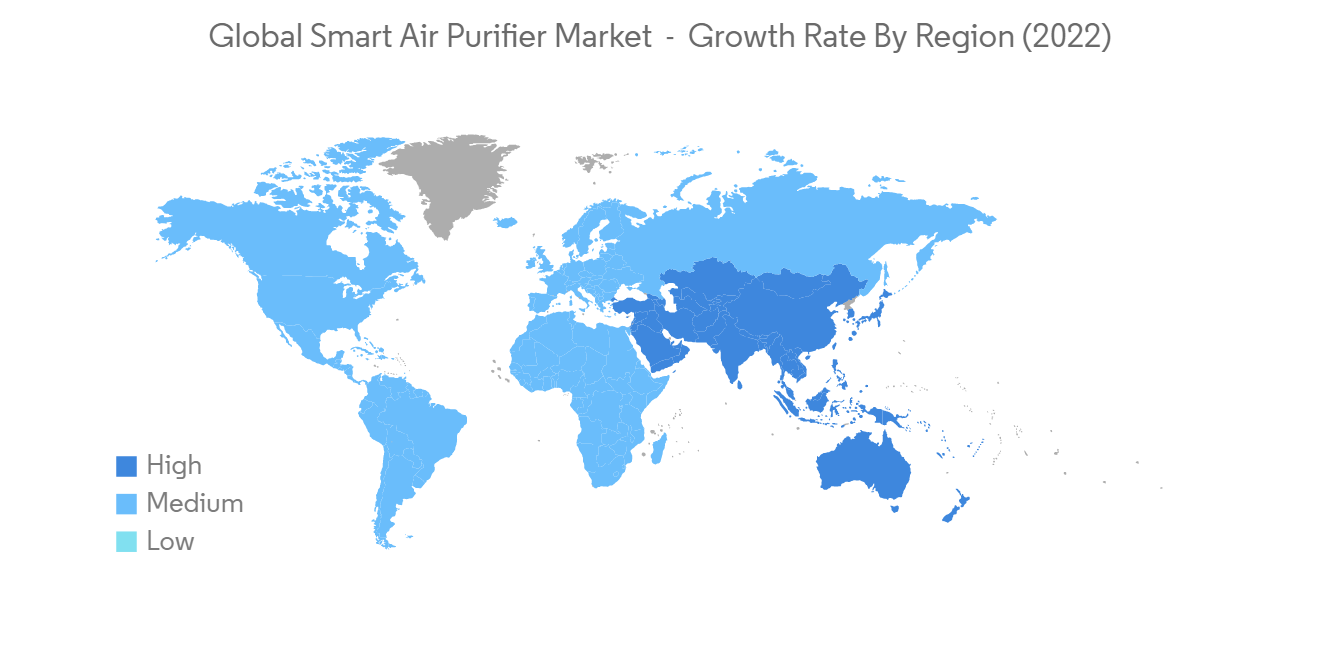 |
市場調查報告書
商品編碼
1258784
智能空氣淨化器市場-增長、趨勢、COVID-19 影響和預測 (2023-2028)Smart Air Purifier Market - Growth, Trends, and Forecasts (2023 - 2028) |
||||||
※ 本網頁內容可能與最新版本有所差異。詳細情況請與我們聯繫。
全球智能空氣淨化器市場預計今年將產生 29.2 億美元的收入,在預測期內實現 10% 的複合年增長率。
智能空氣淨化器是傳統空氣淨化器的現代版本,可為不同的最終用戶自動過濾空氣。 您可以使用通過 Wi-Fi 或藍牙等無線網絡連接的智能手機應用程序遠程控制智能空氣淨化器。 智能空氣淨化器的一個主要好處是客戶可以通過智能手機監控和管理室內空氣質量並調整基本設置。 它還從專用監測傳感器收集空氣質量信息,根據這些數據自動淨化空氣,並在空氣質量發生變化時提醒用戶。
此外,用戶可以通過智能手機應用程序微調空氣淨化設置來進行管理。 智能空氣淨化器主要在室內使用和安裝,例如家庭、小型企業、工業建築和汽車。 智能空氣淨化器配備了自動去除空氣中的煙霧、灰塵和煙霧的技術。 還有一些類型會釋放帶有安全化學物質香味的空氣,這可以增強環境的氛圍和氣味。
由於 COVID-19 疫情,智能空氣淨化器行業的許多公司已決定暫時停止運營,以遵守旨在防止疾病傳播的新政府法規。我是被迫的。 此次關閉對空氣過濾器市場的收入流產生了直接影響。 此外,由於停工期間原材料和工人短缺,工業產品的生產也停止了。 此外,該行業的運營商無法接受新的傭金。 因此,工業活動的停工和隨後幾個月的封鎖影響了智能空氣淨化器的市場份額,儘管市場預計在預測期內將溫和復蘇。
由於快速的城市化和建築活動的增加,城市地區的污染變得更加嚴重。 對環境中清潔、無味、無塵無菸空氣的需求推動了對智能空氣淨化器的需求。 人們越來越注重科技,對高端技術的投資有望對全球經濟擴張產生積極影響。 隨著人均收入的增加和醫療設備支出的增加,空氣淨化器的銷量預計將繼續增長。
高昂的維護成本、頻繁更換過濾器和昂貴的安裝成本使空氣淨化器成為昂貴的設備,阻礙了預測期內的市場增長。
智能空氣淨化器市場趨勢
新興市場污染加劇帶動市場
中國和印度等發展中國家的污染水平非常高,這些國家的許多地區空氣質量指數異常高。 預計某些地區的居民會在家中安裝空氣淨化器,至少可以保持室內空氣清潔。
隨著污染水平的上升,對抗污染產品的需求也在增加,因此市場有望增長。 由於空氣傳播疾病的增加,預計新興國家的產品使用量在不久的將來會增加。 使用空氣淨化器淨化空氣也有助於清潔家中的其他區域。 灰塵包括花粉、黴菌孢子、□蟲、皮膚細胞、頭髮和昆蟲殘骸,帶有 HEPA 過濾器的空氣淨化器可以捕獲這些顆粒。

亞太地區佔比最大
亞太地區的市場份額最高,其次是北美和歐洲。 該地區正在經歷快速的工業化,推動了市場需求。 亞太地區的主要市場是卡塔爾、阿拉伯聯合酋長國、中國和印度。 預計污染水平上升也將推動市場擴張。 此外,帶來更健康生活方式的經濟發展對市場擴張具有積極影響。 在預測期內,中東預計將為世界其他地區做出重大貢獻。
此外,由於每個國家/地區的污染水平不斷增加,亞太地區現在主導著智能空氣淨化器市場。 在預測期內,空氣質量分級評估響應系統和車用低排放轉換器等政策的增加也將有助於智能空氣淨化器市場的發展。 由於健康意識的提高,預計北美智能空氣淨化器市場將出現可觀的增長。 此外,由於旨在提高空氣質量標準的嚴格政府法規,該地區的智能空氣淨化器市場預計在未來幾年將會增長。

智能空氣淨化器行業概況
製造商正在使用新技術將新產品推向市場。 每個公司都使用不同的營銷策略來增加其市場份額。 一些市場領導者正在大力投資研發活動,以提高他們在當前電子技術和流程中的地位,從而提高效率並降低成本。
其他福利:
- Excel 格式的市場預測 (ME) 表
- 3 個月的分析師支持
內容
第一章介紹
- 研究假設和市場定義
- 調查範圍
第二章研究方法論
第 3 章執行摘要
第 4 章市場動態和洞察
- 市場概覽
- 市場驅動力
- 市場製約因素
- 價值鏈分析
- 行業吸引力:波特的五力分析
- 新進入者的威脅
- 買家的議價能力
- 供應商的議價能力
- 替代品的威脅
- 競爭對手之間的競爭強度
- 對行業技術進步的洞察力
- 對影響市場的各種監管發展的見解
- 關於 COVID-19 對市場的影響
第 5 章市場細分
- 按類型
- 除塵器
- 煙霧收集器
- 其他
- 按技術
- 高效空氣過濾器
- 活性炭過濾
- 其他
- 通過申請
- 住宅
- 商業
- 其他
- 分銷渠道
- 超市/大賣場
- 專賣店
- 在線
- 其他分銷渠道
- 按地區
- 北美
- 歐洲
- 亞太地區
- 南美洲
- 中東和非洲
第6章競爭格局
- 市場集中度概述
- 公司簡介
- Sharp Corporation
- Dyson Limited
- Xiaomi Corporation
- Honeywell International, Inc.
- Hamilton Beach Brands, Inc
- Koninklijke Philips NV
- LG Electronics, Inc.(LG Corp)
- Havells India Ltd.
- Sunbeam Products Inc.
- Coway Co., Ltd.
- Levoit(Vesync Co., Ltd.)
- Unilever PLC(Blueair AB)
- Smart Air Filters Pvt Ltd.
- Whirlpool Corporation
- Winix Inc.*
第7章 市場機會與今後動向
第8章 免責事項及關於Mordor Intelligence
The Global Smart Air Purifier Market has generated a revenue of USD 2.92 billion in the current year and is poised to achieve a CAGR of 10% for the forecast period.
The smart air purifier is a modern version of a traditional air purifier that automatically filters the air for various end users. It can be controlled remotely by using an app on smartphones linked to smart air purifiers via wireless networks like Wi-Fi and Bluetooth. The main advantage of the smart air purifier is that customers can monitor and manage indoor air quality and adjust basic settings via smartphones. Additionally, these gadgets collect information on air quality from specialized monitoring sensors, automatically clean the air in accordance with that data, and alert users when air quality levels change.
Users can manage these purifiers by fine-tuning the air-cleaning settings using apps designed for smartphones. Smart air purifiers are mostly used and installed in indoor settings, including homes, small businesses and industrial buildings, and automobiles. Smart air purifiers come with technology that automatically removes smoke, dust, and fumes from the air. These gadgets come in versions that release air scented with safe chemicals that can enhance the ambiance and aroma of the environment.
Because of the COVID-19 pandemic, many companies in the smart air purifiers industry were forced to temporarily halt operations in order to comply with new government regulations aimed at preventing disease spread. This halt in operations had a direct impact on the revenue flow of the air filter market. Furthermore, due to a lack of raw materials and workers during the lockdown, industrial product production has ceased. Furthermore, no new consignments were received by businesses in this industry. As a result, the suspension of industrial activities and subsequent lockdown for several months had an impact on smart air purifier market share, and the market is expected to recover slowly during the projection period.
Urban areas have become much more polluted as a result of fast urbanization and increased construction activities. The need for smart air purifiers is being driven by the requirement for clean, odorless, dust- and smoke-free air in the environment. People are now more technologically oriented, and considerable investments in high-end technological items are anticipated to be positive signs for the expansion of the global economy. Due to rising per capita income and spending on medical equipment, it is projected that sales of these air purifiers would continue to climb in the near future.
High maintenance costs, frequent filter replacement, and premium installation fees have made air purifiers an overpriced expensive gadget, impeding market growth in the forecasted period.
Smart Air Purifier Market Trends
Increasing Pollution in Developing Countries Driving the Market
The pollution levels in developing nations like China and India are exceedingly high, and many regions in these nations have exceptionally high air quality index readings. In order to at least maintain clean and fresh indoor air, residents of certain localities are expected to install air purifiers in their houses.
Due to the increased demand for anti-pollution products, as pollution levels rise, the market is anticipated to grow. In the near future, product use is anticipated to increase in emerging nations due to the increased prevalence of airborne illnesses. Using an air purifier to purify the air also aids in cleaning the rest of the house. The airborne particles that make up dust include pollen, mold spores, dust mites, human skin cells, hair, and insect debris; these particles may be captured by air purifiers equipped with a HEPA filter.

Asia-Pacific Held the Largest Share in the Market
The Asia-Pacific region has the largest market share, followed by North America and Europe. The region's rapidly growing industrialization is driving market demand. The major markets in the Asia Pacific are Qatar, the United Arab Emirates, China, and India. Rising pollution levels are also expected to drive Market expansion. Furthermore, economic development that leads to a healthier lifestyle has a positive impact on market growth. The Middle East is expected to contribute significantly to the rest of the world during the forecast period.
Furthermore, due to the growth in pollution levels in various nations, Asia-Pacific now holds a monopoly on the market for smart air purifiers. During the course of the projection period, an increase in policies like the graded air quality rating response system and emission-reducing converters for cars will also help the market for smart air purifiers develop. Due to a surge in health consciousness, North America is expected to have considerable growth in the smart air purifier market. Furthermore, it is projected that the region's market for smart air purifiers would rise in the next years due to the tight government rules intended to raise the standards for air quality.

Smart Air Purifier Industry Overview
The global smart air purifier market is fragmented due to the presence of a large number of global and regional players in the market like Sharp Corporation, Dyson Limited, Xiaomi Corporation, Honeywell International, Inc., Hamilton Beach Brands, Inc., Koninklijke Philips N.V., and LG Electronics, Inc., among others. Manufacturers are introducing new products in the market using new technologies. The companies use various marketing strategies to increase their market shares. Some of the market's leading players are heavily investing in research and development activities to improve their position in current electronic technologies and processes in order to increase efficiency and lower costs.
Additional Benefits:
- The market estimate (ME) sheet in Excel format
- 3 months of analyst support
TABLE OF CONTENTS
1 INTRODUCTION
- 1.1 Study Assumptions and Market Definition
- 1.2 Scope of the Study
2 RESEARCH METHODOLOGY
3 EXECUTIVE SUMMARY
4 MARKET DYNAMICS AND INSIGHTS
- 4.1 Market Overview
- 4.2 Market Drivers
- 4.3 Market Restraints
- 4.4 Value Chain Analysis
- 4.5 Industry Attractiveness: Porter's Five Forces Analysis
- 4.5.1 Threat of New Entrants
- 4.5.2 Bargaining Power of Buyers
- 4.5.3 Bargaining Power of Suppliers
- 4.5.4 Threat of Substitutes
- 4.5.5 Intensity of Competitive Rivalry
- 4.6 Insights into Technological Advancements in the Industry
- 4.7 Insights on Various Regulatory Trends Shaping the Market
- 4.8 Impact of COVID-19 on the Market
5 MARKET SEGMENTATION
- 5.1 By Type
- 5.1.1 Dust Collectors
- 5.1.2 Fume & Smoke Collectors
- 5.1.3 Others
- 5.2 By Technology
- 5.2.1 HEPA
- 5.2.2 Activated Carbon Filtration
- 5.2.3 Others
- 5.3 By Application
- 5.3.1 Residential
- 5.3.2 Commercial
- 5.3.3 Others
- 5.4 Distribution Channel
- 5.4.1 Supermarkets/Hypermarkets
- 5.4.2 Specialty Stores
- 5.4.3 Online
- 5.4.4 Other Distribution Channels
- 5.5 By Geography
- 5.5.1 North America
- 5.5.2 Europe
- 5.5.3 Asia-Pacific
- 5.5.4 South America
- 5.5.5 Middle-East and Africa
6 COMPETITIVE LANDSCAPE
- 6.1 Market Concentration Overview
- 6.2 Company Profiles
- 6.2.1 Sharp Corporation
- 6.2.2 Dyson Limited
- 6.2.3 Xiaomi Corporation
- 6.2.4 Honeywell International, Inc.
- 6.2.5 Hamilton Beach Brands, Inc
- 6.2.6 Koninklijke Philips NV
- 6.2.7 LG Electronics, Inc.(LG Corp)
- 6.2.8 Havells India Ltd.
- 6.2.9 Sunbeam Products Inc.
- 6.2.10 Coway Co., Ltd.
- 6.2.11 Levoit (Vesync Co., Ltd.)
- 6.2.12 Unilever PLC (Blueair AB)
- 6.2.13 Smart Air Filters Pvt Ltd.
- 6.2.14 Whirlpool Corporation
- 6.2.15 Winix Inc.*













